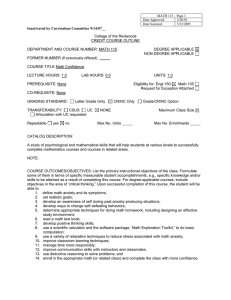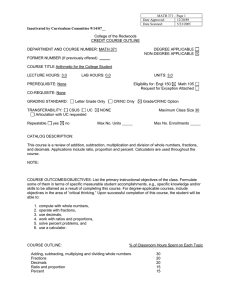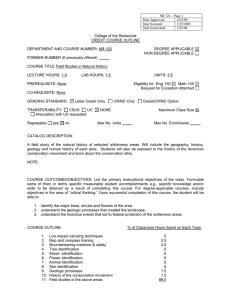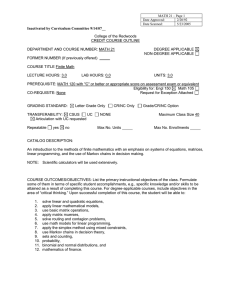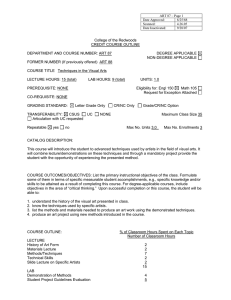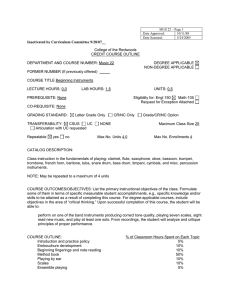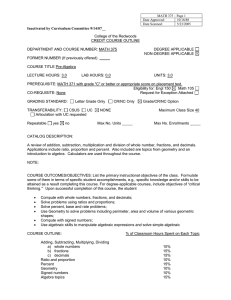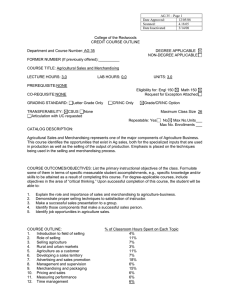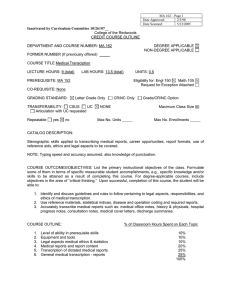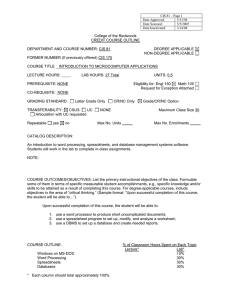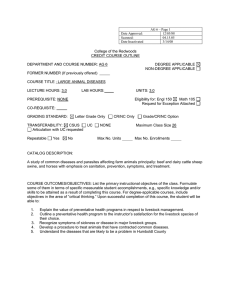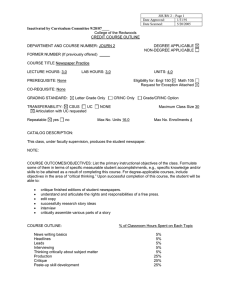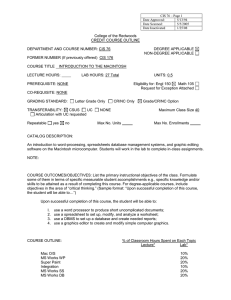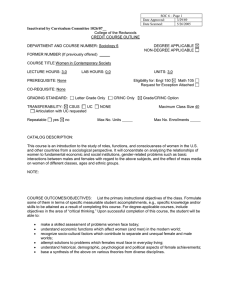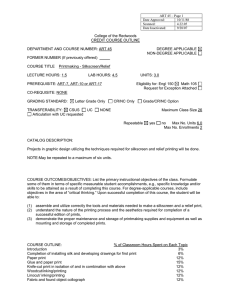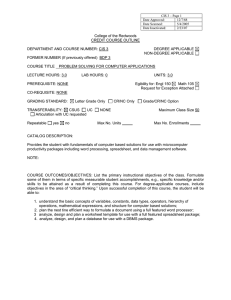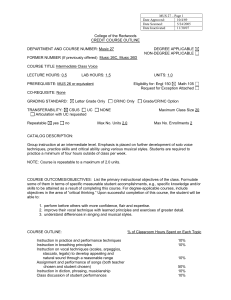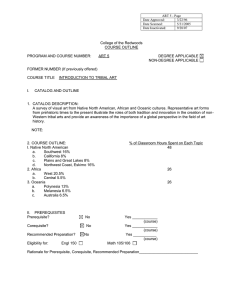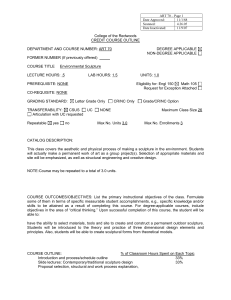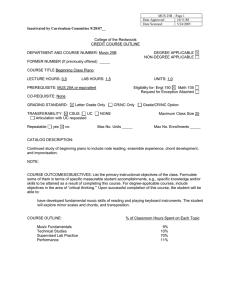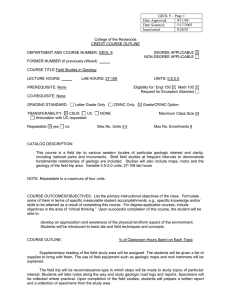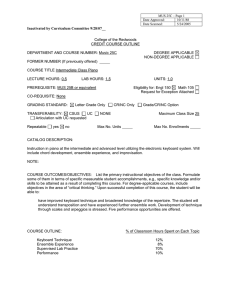Document 12362955
advertisement
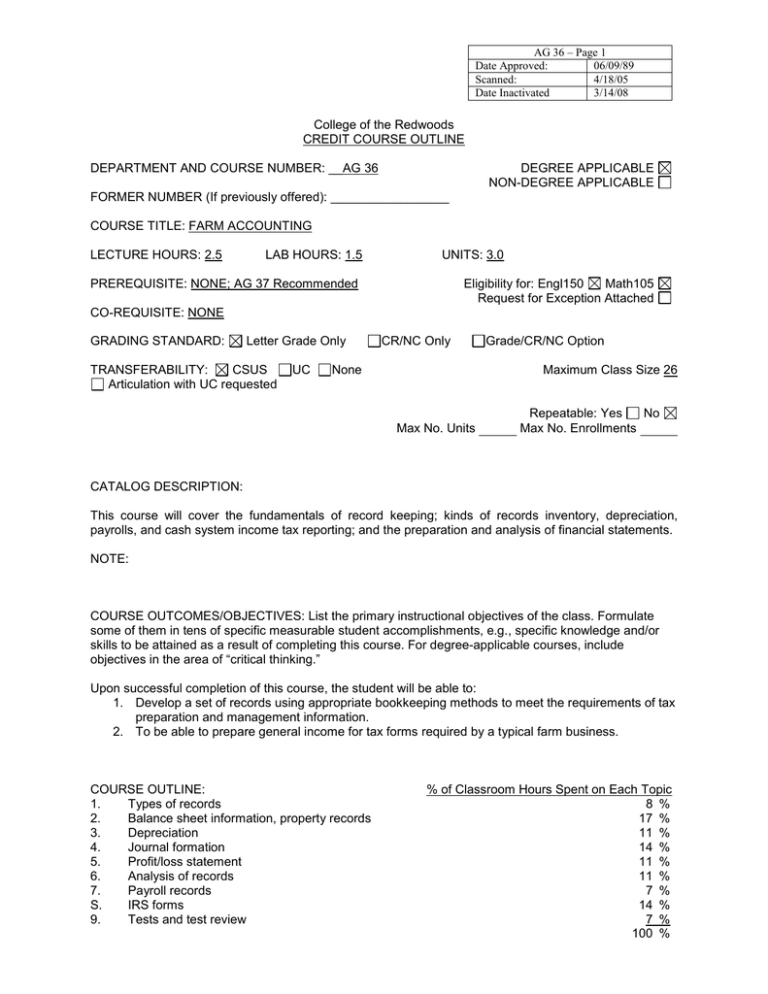
AG 36 – Page 1 Date Approved: 06/09/89 Scanned: 4/18/05 Date Inactivated 3/14/08 College of the Redwoods CREDIT COURSE OUTLINE DEPARTMENT AND COURSE NUMBER: __AG 36 DEGREE APPLICABLE NON-DEGREE APPLICABLE FORMER NUMBER (If previously offered): _________________ COURSE TITLE: FARM ACCOUNTING LECTURE HOURS: 2.5 LAB HOURS: 1.5 UNITS: 3.0 PREREQUISITE: NONE; AG 37 Recommended Eligibility for: Engl150 Math105 Request for Exception Attached CO-REQUISITE: NONE GRADING STANDARD: Letter Grade Only TRANSFERABILITY: CSUS Articulation with UC requested UC CR/NC Only None Grade/CR/NC Option Maximum Class Size 26 Max No. Units Repeatable: Yes No Max No. Enrollments CATALOG DESCRIPTION: This course will cover the fundamentals of record keeping; kinds of records inventory, depreciation, payrolls, and cash system income tax reporting; and the preparation and analysis of financial statements. NOTE: COURSE OUTCOMES/OBJECTIVES: List the primary instructional objectives of the class. Formulate some of them in tens of specific measurable student accomplishments, e.g., specific knowledge and/or skills to be attained as a result of completing this course. For degree-applicable courses, include objectives in the area of “critical thinking.” Upon successful completion of this course, the student will be able to: 1. Develop a set of records using appropriate bookkeeping methods to meet the requirements of tax preparation and management information. 2. To be able to prepare general income for tax forms required by a typical farm business. COURSE OUTLINE: 1. Types of records 2. Balance sheet information, property records 3. Depreciation 4. Journal formation 5. Profit/loss statement 6. Analysis of records 7. Payroll records S. IRS forms 9. Tests and test review % of Classroom Hours Spent on Each Topic 8 % 17 % 11 % 14 % 11 % 11 % 7 % 14 % 7 % 100 % AG 36 – Page 2 Date Approved: 06/09/89 Scanned: 4/18/05 Date Inactivated 3/14/08 APPROPRIATE TEXTS AND MATERIALS: (Indicate textbooks that may be required or recommended, including alternate texts that may be used.) Text(s) Title: FM321 Problem Set, Cal Poly Required Edition: Alternate Author: Recommended Publisher: El Corral Bookstore Date Published: 1989 Title: Farmers Tax Guide Pub 225 Required Edition: Alternate Author: Recommended Publisher: Internal Revenue Service Date Published: 1989 (Additional required, alternate, or recommended texts should be listed on a separate sheet and attached.) For degree applicable courses the adopted texts have been certified to be college-level: Yes. Basis for determination: is used by two or more four-year colleges or universities (certified by the Division Chair or Branch Coordinator, or Center Dean) OR has been certified by the LAC as being of college level using the Coleman and Dale-Chall Readability Index Scale. No. Request for Exception Attached If no text or a below college level text is used in a degree applicable course, a Request for Exception form must be completed and a rationale provided. This request for exception will be approved or denied by the Curriculum Committee. AG 36 – Page 3 Date Approved: 06/09/89 Scanned: 4/18/05 Date Inactivated 3/14/08 METHODS TO MEASURE STUDENT ACHIEVEMENT: Please check where appropriate; however, a degree applicable course must have a minimum of one response in category 1, 2, or 3. If category 1 is not checked, the department must explain why substantial writing assignments are an inappropriate basis for at least part of the grade. 1. Substantial writing assignments, including: essay exam(s) term or other paper(s) written homework reading report(s) other (specify) Accounting Problem Set laboratory report(s) If the course is degree applicable, substantial writing assignments in this course are inappropriate because: The course is primarily computational in nature. The course primarily involves skill demonstrations or problem solving. Other rationale (explain) __________________________________________ 2. Computational or Non-computational problem-solving demonstrations, including: exam(s) quizzes homework problems laboratory report(s) field work other (specify)_______ 3. Skill demonstrations, including: class performance(s) other (specify)____ 4. Objective examinations, including: multiple choice completion field work performance exam(s) true/false other (specify) matching items 5. Other (specify) Fill-ins NOTE: A course grade may not be based solely on attendance. REQUIRED READING, WRITING, AND OTHER OUTSIDE OF CLASS ASSIGNMENTS: Over an 18-week presentation of the course, 3 hours per week are required for each unit of credit. ALL Degree Applicable Credit classes must treat subject matter with a scope and intensity which require the student to study outside of class. Two hours of independent work done out of class are required for each hour of lecture. Lab and activity classes must also require some outside of class work. Outside of the regular class time the students in this class will be doing the following: Study Answer questions Skill practice Required reading Problem solving activity or exercise Written work (essays/compositions/report/analysis/research) Journal (reaction and evaluation of class, done on a continuing basis throughout the semester) Observation of or participation in an activity related to course content (e.g., play, museum, concert, debate, meeting, etc.) Field trips Other (specify) ____________________________ AG 36 – Page 4 Date Approved: 06/09/89 Scanned: 4/18/05 Date Inactivated 3/14/08 COLLEGE LEVEL CRITICAL THINKING TASKS/ASSIGNMENTS: Degree applicable courses must include critical thinking tasks/assignments. This section need not be completed for non-degree applicable courses. Describe how the course requires students to independently analyze, synthesize, explain, assess, anticipate and/or define problems, formulate and assess solutions, apply principles to new situations, etc. The student will be able to identify the major components of a complete farm accounting system and relate them to an actual farm business. The student will be able to evaluate and analyze the information contained in the accounting system relative to making management decisions. METHOD OF EVALUATION: 1. Attendance and participation 2. Problem set 3. Assignments 4. Tests (3) 5. Final Exam GRADE SCALE: 92-l00 = A, 82-91 = B, 72-81 = C, 62-71 = D, 0-61 = F Based on top score % OF GRADE 10 % 20 % 10 % 35 % 25 %
